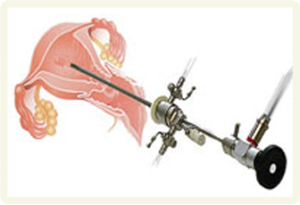
Purpose of Hysteroscopy:
- Diagnosis:
-
- Evaluate Abnormal Bleeding: Hysteroscopy helps investigate the causes of abnormal uterine bleeding, such as heavy or irregular periods, spotting between periods, or postmenopausal bleeding.
- Examine Uterine Abnormalities: It allows for the detailed assessment of conditions such as uterine fibroids, polyps, congenital anomalies, or abnormal growths.
- Investigate Infertility: For women experiencing difficulty conceiving, hysteroscopy can help identify uterine factors that may contribute to infertility, such as septum or adhesions.
- Treatment:
-
- Remove Polyps and Fibroids: Hysteroscopy enables the removal of polyps or fibroids from the uterine cavity, which can alleviate symptoms and improve reproductive health.
- Resect Endometrial Tissue: It can be used to perform a hysteroscopic resection of the endometrial lining in cases of abnormal bleeding or hyperplasia.
- Correct Uterine Abnormalities: Hysteroscopy can address structural issues such as uterine septum or intrauterine adhesions (Asherman’s syndrome), which may impact fertility or cause other complications.
- Follow-Up:
-
- Postoperative Assessment: It is used for follow-up evaluations to ensure that previously treated conditions have been resolved and to monitor the healing process.
DIAGNOSTIC HYSTEROLAPAROSCOPY
At CIMAR, The Women’s Hospital, we offer diagnostic hysteroscopy and laparoscopy as advanced techniques for evaluating and diagnosing a range of gynecological conditions. These minimally invasive procedures provide detailed insights into the reproductive organs, allowing for accurate diagnosis and appropriate management.
What is Diagnostic Hysteroscopy?
Diagnostic hysteroscopy involves inserting a hysteroscope—a thin, lighted tube equipped with a camera—through the vagina and cervix into the uterus. This procedure allows for direct visualization of the uterine cavity, enabling the assessment of various conditions affecting the uterine lining and structure.
Purpose of Diagnostic Hysteroscopy:
- Evaluate Abnormal Bleeding: To investigate the causes of abnormal uterine bleeding, including heavy periods, irregular bleeding, or postmenopausal bleeding.
- Examine Uterine Abnormalities: To identify issues such as polyps, fibroids, or congenital uterine anomalies that may impact menstrual health or fertility.
- Assess Infertility: To determine if uterine conditions are contributing to infertility or recurrent miscarriages.
- Inspect for Endometrial Pathologies: To diagnose conditions such as endometrial hyperplasia or cancer, particularly if abnormal cells or thickening of the endometrial lining are suspected.
What is Diagnostic Laparoscopy?
Diagnostic laparoscopy involves inserting a laparoscope—a thin, lighted tube equipped with a camera—through small incisions in the abdomen. This procedure allows for visualization of the pelvic organs, including the uterus, ovaries, and fallopian tubes, to assess their health and structure.
Purpose of Diagnostic Laparoscopy:
- Investigate Pelvic Pain: To diagnose the cause of unexplained pelvic pain, which may be due to conditions such as endometriosis, pelvic adhesions, or ovarian cysts.
- Evaluate Infertility: To identify potential causes of infertility, such as blocked fallopian tubes, endometriosis, or pelvic adhesions.
- Assess Uterine and Ovarian Conditions: To evaluate abnormalities such as fibroids, ovarian cysts, or tumors that may impact reproductive health.
- Detect and Diagnose: To diagnose conditions that are not easily visible through other imaging techniques, such as certain types of pelvic masses or abnormalities.
Myomectomy uses and benefits:
- Symptom Relief: Myomectomy can help alleviate common symptoms associated with fibroids, such as heavy menstrual bleeding, pelvic pain, frequent urination, and pressure on the bladder or rectum.
- Preservation of Fertility: For women who wish to conceive in the future, myomectomy offers the advantage of preserving the uterus, which is essential for maintaining fertility.
- Improved Quality of Life: By removing fibroids and relieving symptoms, the procedure can significantly improve quality of life, including reducing pain and discomfort and enhancing overall well-being.
- Customized Treatment: Myomectomy can be tailored to address the size, location, and number of fibroids, ensuring that each patient receives a treatment plan suited to her specific needs.